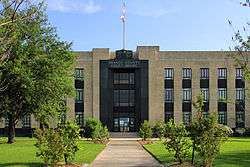Charles Henry Page
Charles Henry Page (1876–1957) was an architect who was born in St. Louis, Missouri, but moved to Texas with his family when he was ten years old . He was commissioned to design the Texas Building at the 1904 St. Louis World's Fair.[1] He and his brother Louis Charles Page founded the Texas firm of Page Brothers Architects, sometimes referred to in various documents as C.H. Page and Brothers of Austin or C.H. Page and Brother, and designed many courthouses in the U.S. state of Texas. The brothers also had a partnership with Louis Southerland known as Page, Southerland and Page.[2]
Texas courthouses
The 1908 Fort Bend County Courthouse designed by the brothers was placed on the National Registor of Historic Places (NRHP) in 1980.[3] The brothers also designed the 1908 Hays County Courthouse, which was added to the NRHP in 1992.[4] The 1911 Williamson County Courthouse designed by the brothers is a contributing property to the 1977 NRHP designation of the Williamson County Courthouse Historical District.[5] In 1914, the brothers designed the Anderson County Courthouse, which was added to the NRHP in 1992.[6] The 1923–1924 modernization of the Bastrop County Courthouse was designed by Page, Southerland and Page and replaced the original roof, updated the clock tower, and renovated the interior. Combined with the county jail, it was added to the NRHP in 1975.[7] In 1929, the brothers designed the Hunt County Courthouse, which was placed on the NRHP in 1996.[8] Page also designed the 1936 Austin federal courthouse, which was added to the NRHP in 2001.[9] The 1937 Orange County Courthouse designed by the brothers replaced the 1898 courthouse.[10]
Other Designs
Page designed the station at Crowley, Louisiana, built in 1907 for the Colorado Southern, New Orleans and Pacific Railroad.[11]
Personal
Page lived in the Pemberton Heights district of Austin, Texas.[12] He died in 1957 and is buried at Oakwood Cemetery in Austin.[13]
Gallery
- Fort Bend County Courthouse, Texas
 Williamson County Courthouse, Texas
Williamson County Courthouse, Texas Anderson County Courthouse, Texas
Anderson County Courthouse, Texas.jpg) Hunt County Courthouse, Texas
Hunt County Courthouse, Texas Orange County Courthouse, Texas
Orange County Courthouse, Texas United States Courthouse, Austin, Texas
United States Courthouse, Austin, Texas- Railroad Depot, Crowley, Louisiana
References
- ↑ Texas School Journal, Volume 20. 1902. p. 427.
- ↑ Williamson, Roxanne. "Charles Henry Page". Handbook of Texas Online. Texas State Historical Association. Retrieved September 2, 2013.
- ↑ "Fort Bend County Courthouse". Texas Historical Commission. Retrieved September 2, 2013.
- ↑ "Hays County Courthouse". Texas Historical Commission. Retrieved September 2, 2013.
- ↑ "Williamson County Courthouse Historical District". Texas Historical Commission. Retrieved September 2, 2013.
- ↑ "Anderson County Courthouse". Texas Historical Commission. Retrieved September 2, 2013.
- ↑ "Bastrop County Courthouse". Texas Historical Commission. Retrieved September 2, 2013.
- ↑ "Hunt County Courthouse". Texas Historical Commission. Retrieved September 2, 2013.
- ↑ "U.S. Courthouse, Austin, TX". General Services Administration. Retrieved 3 August 2016.
- ↑ "Orange County Courthouse". Texas Escapes. Blueprints For Travel, LLC. Retrieved September 2, 2013."Orange County Courthouse". Texas Historical Commission. Retrieved September 3, 2013.
- ↑ "Historic Colorado Southern Railroad Depot" in SAH Archipedia, eds. Gabrielle Esperdy and Karen Kingsley, Charlottesville: UVaP, 2012—, http://sah-archipedia.org/buildings/LA-01-AC6. Accessed 2016-08-13.
- ↑ Cash, Elizabeth A; Deaderick, Suzanne B (2012). Austin's Pemberton Heights. Arcadia Publishing. p. 119. ISBN 978-0738595894.
- ↑ Charles Henry Page at Find a Grave
External links
| Wikimedia Commons has media related to Charles Henry Page. |